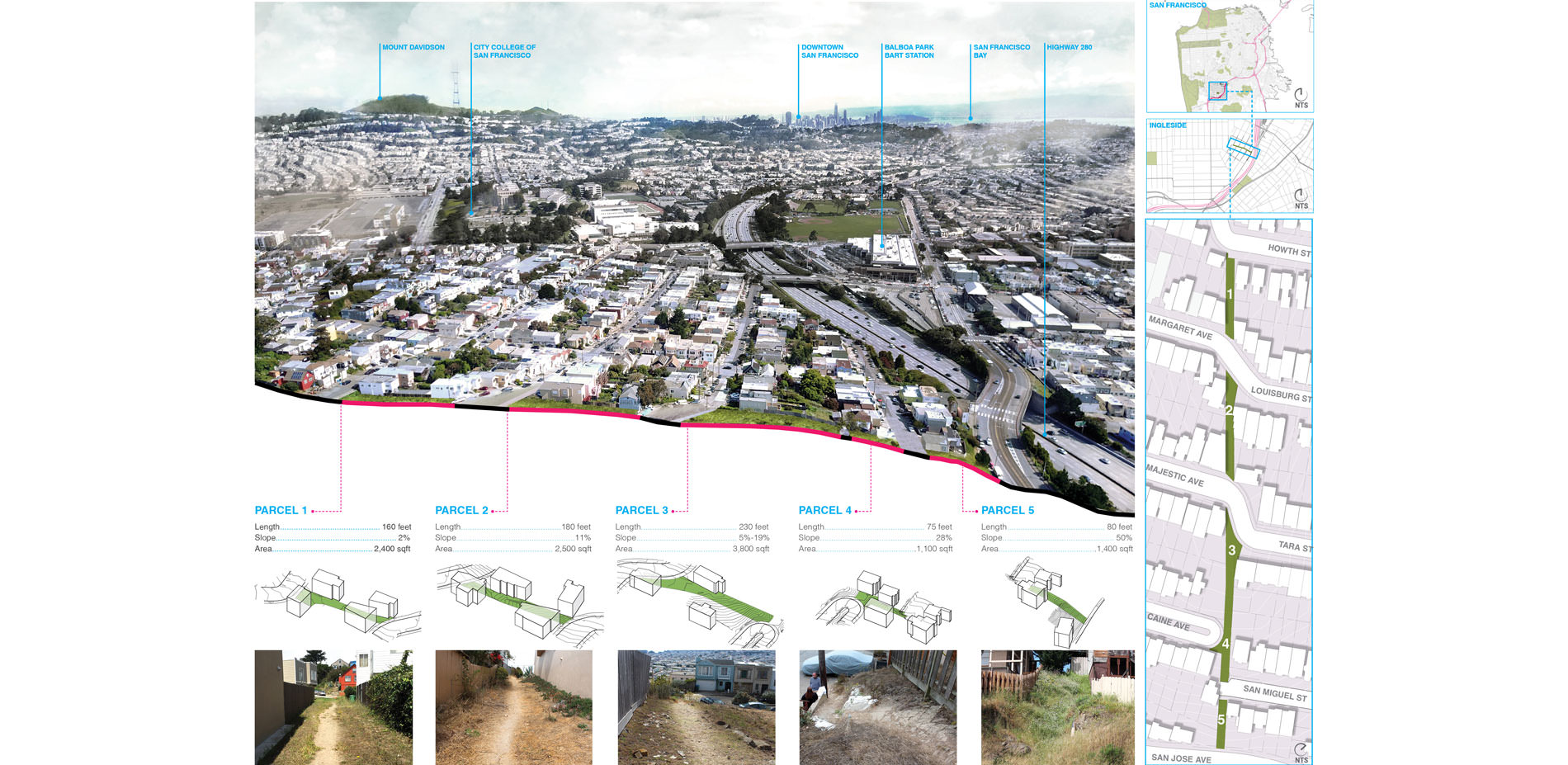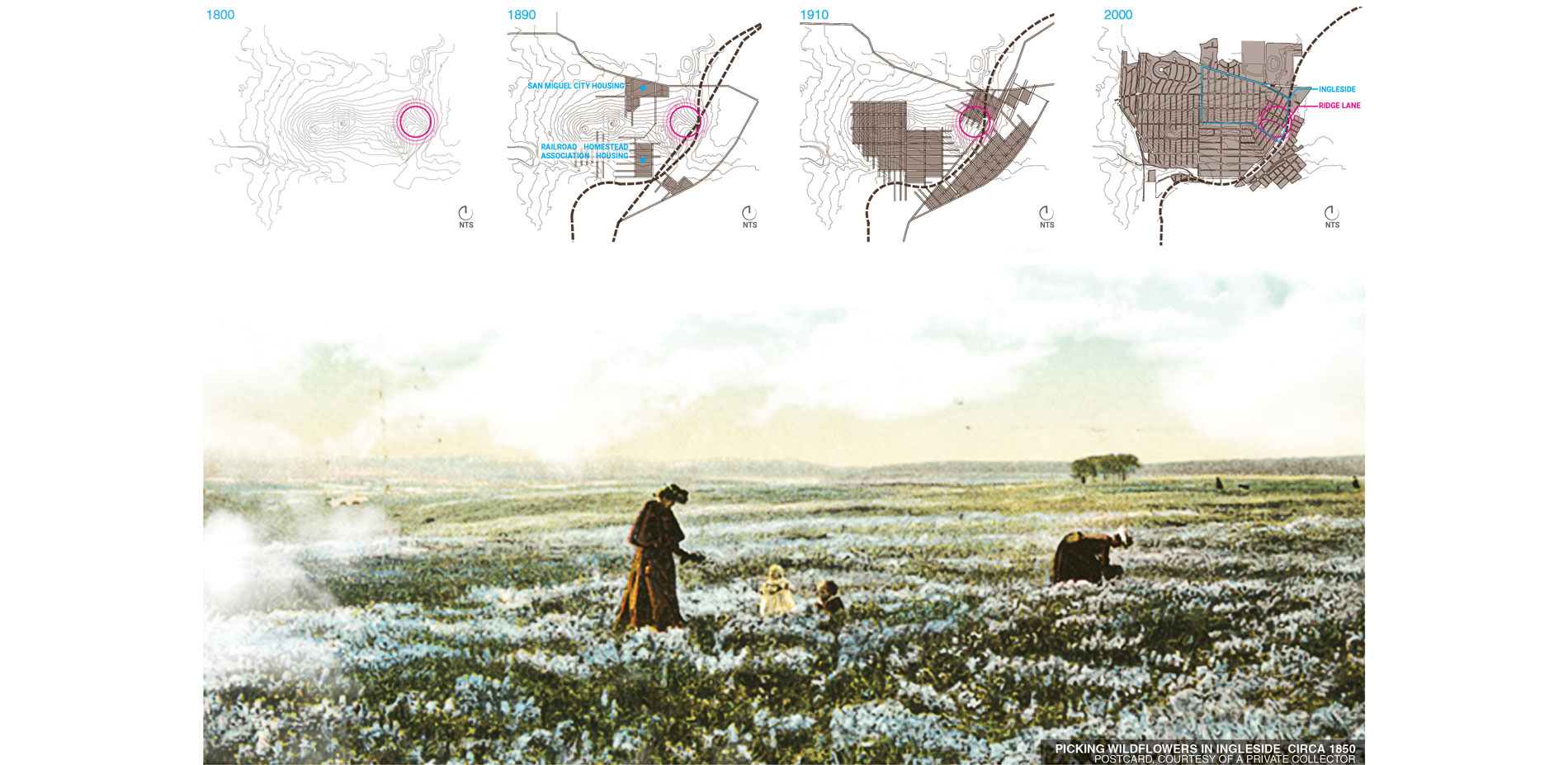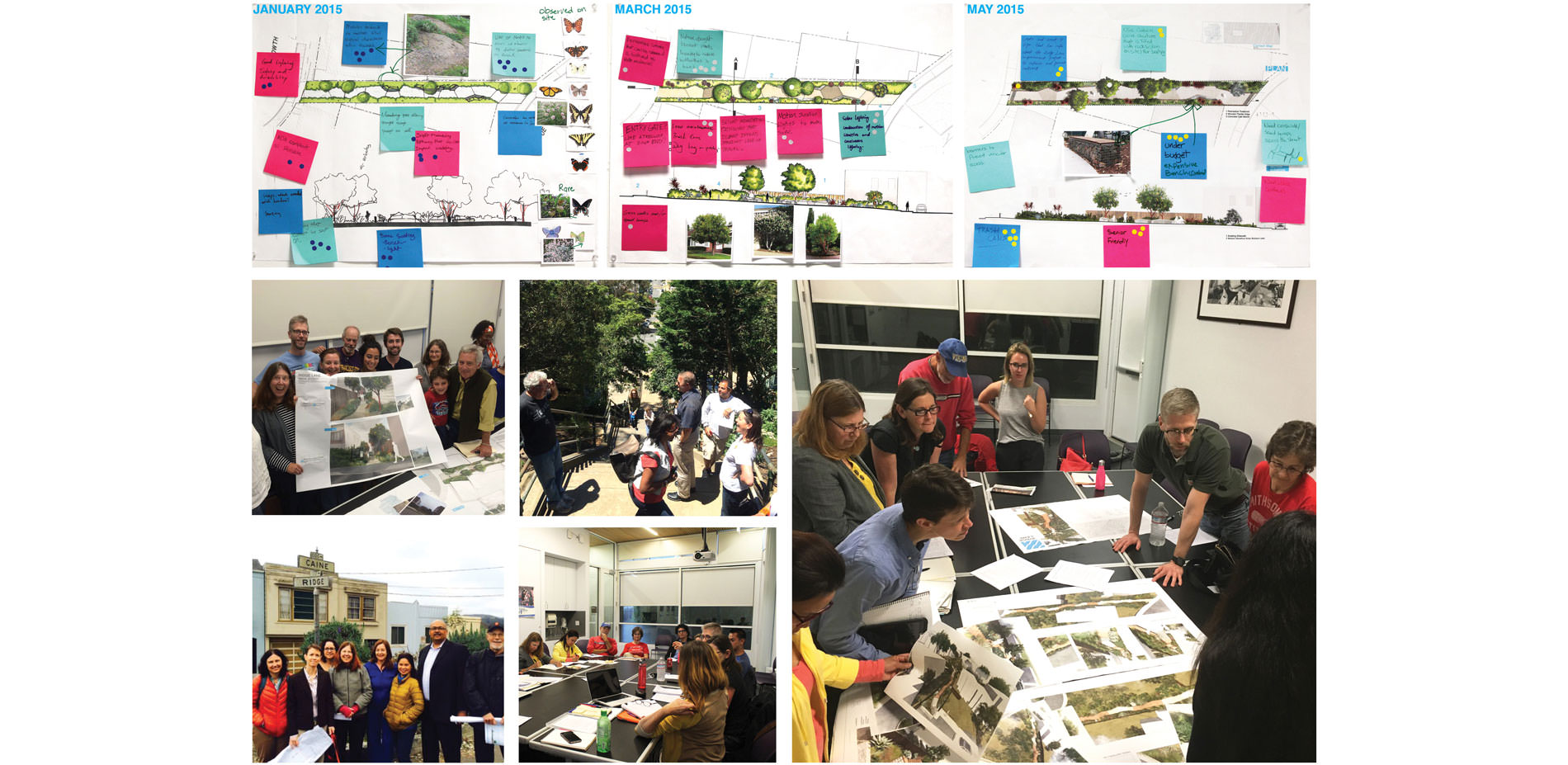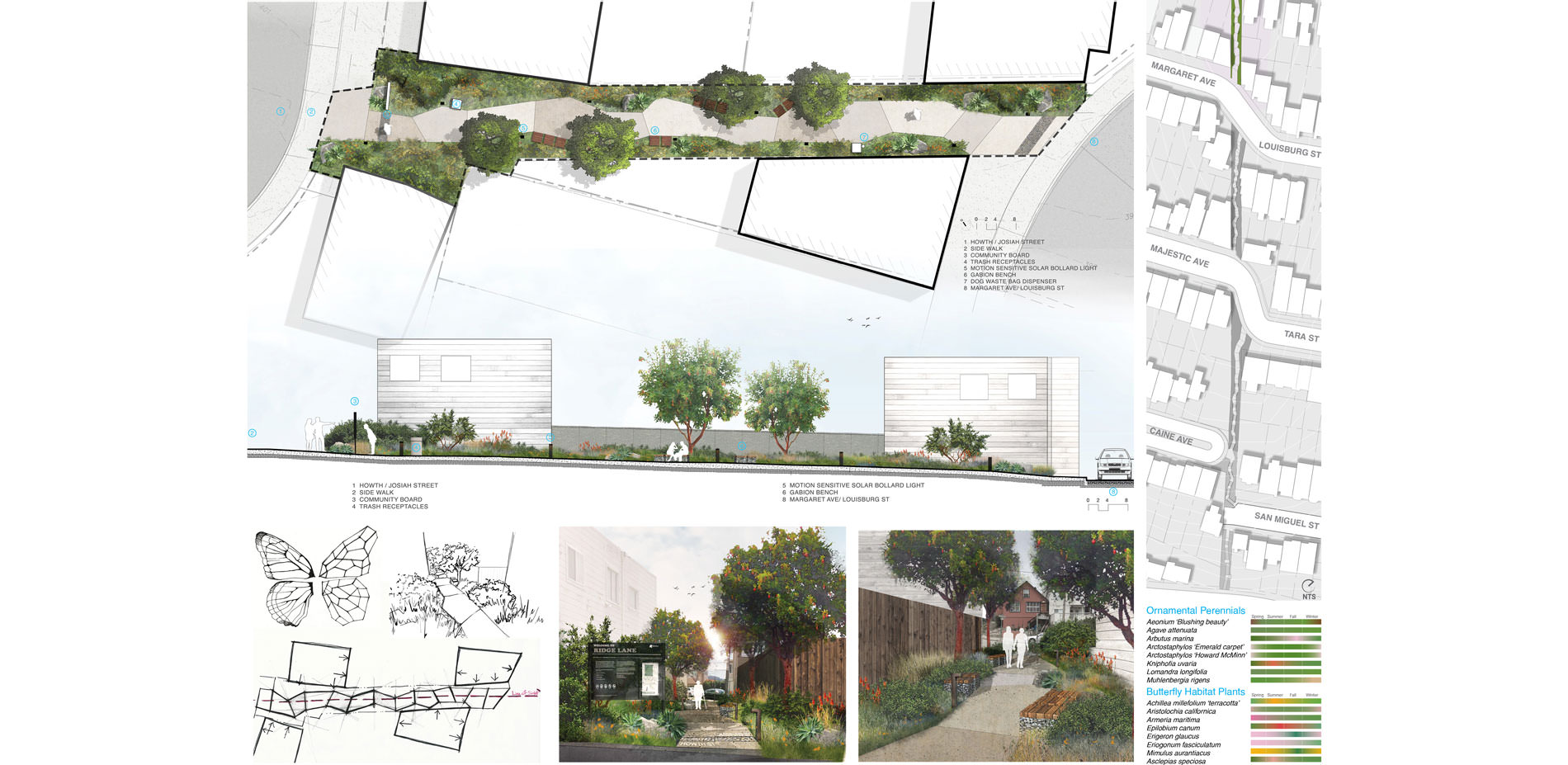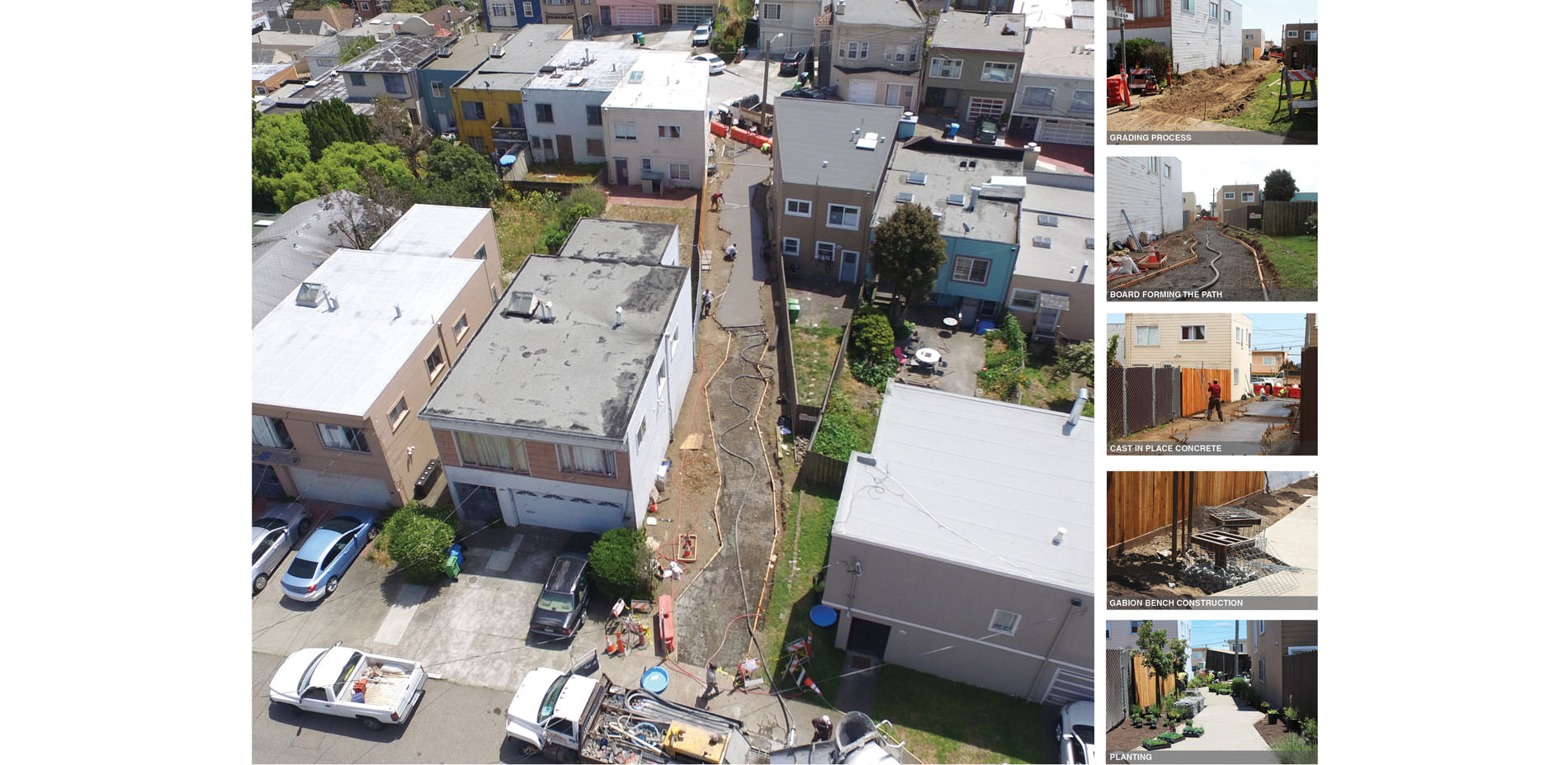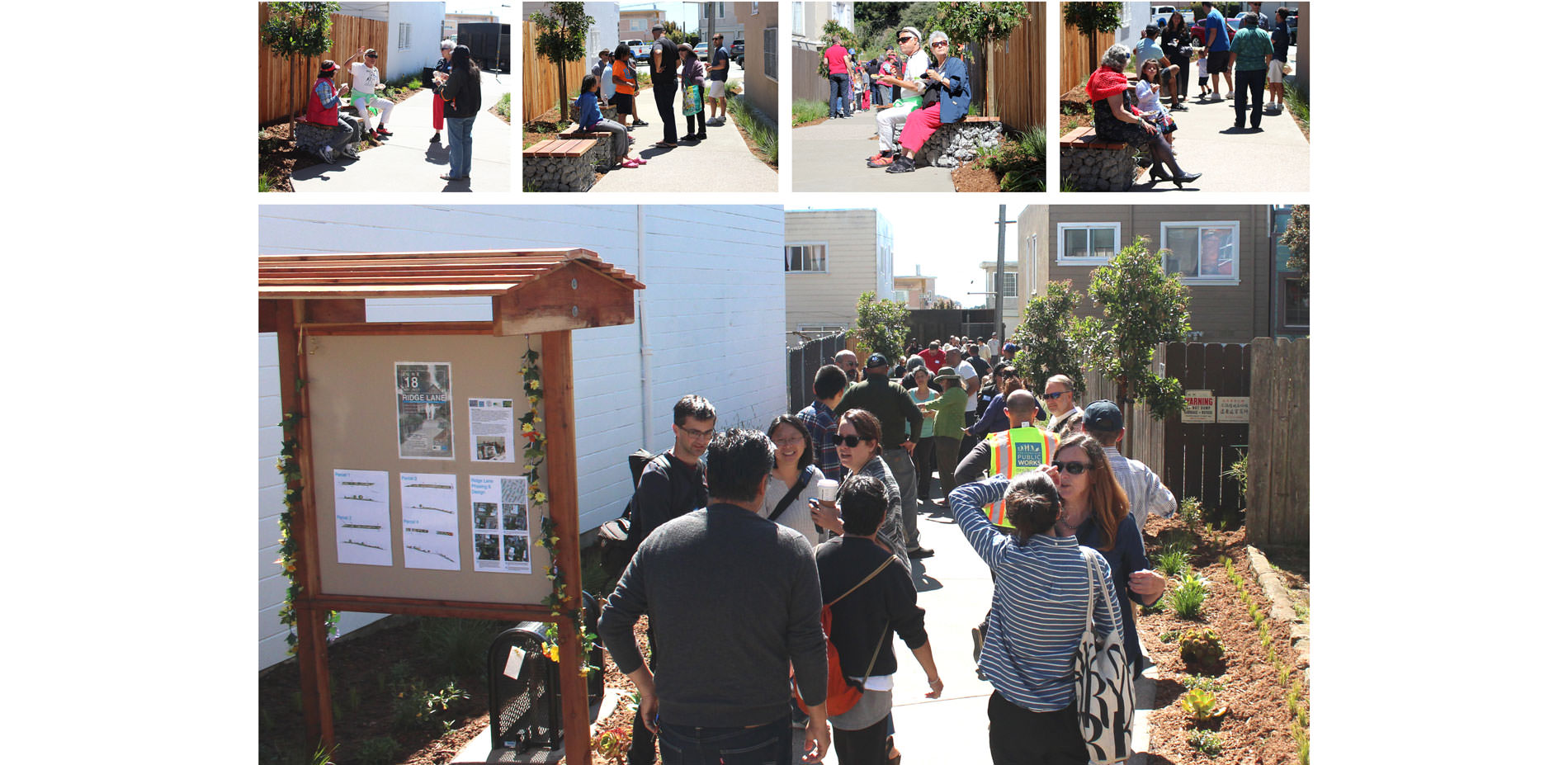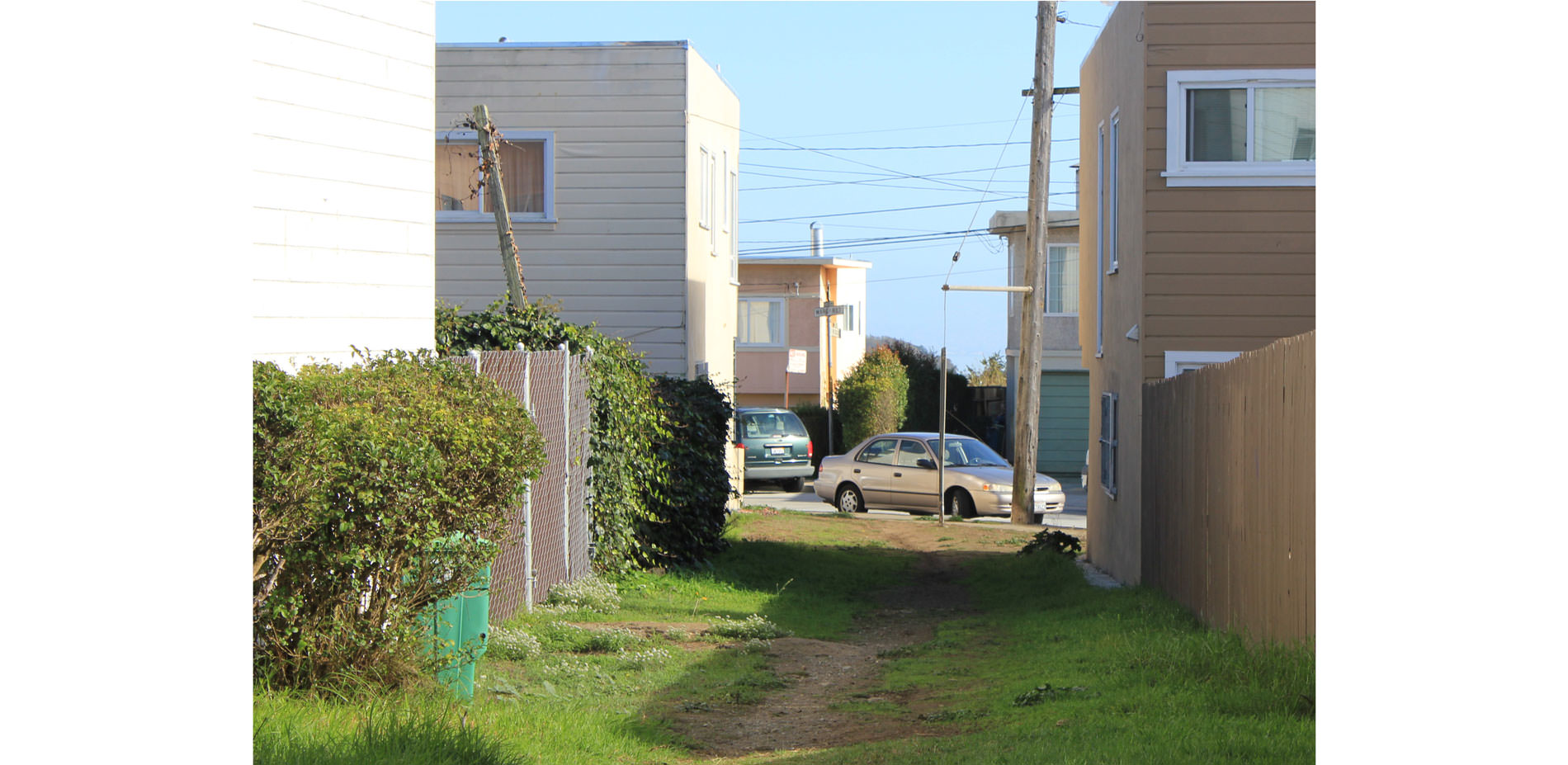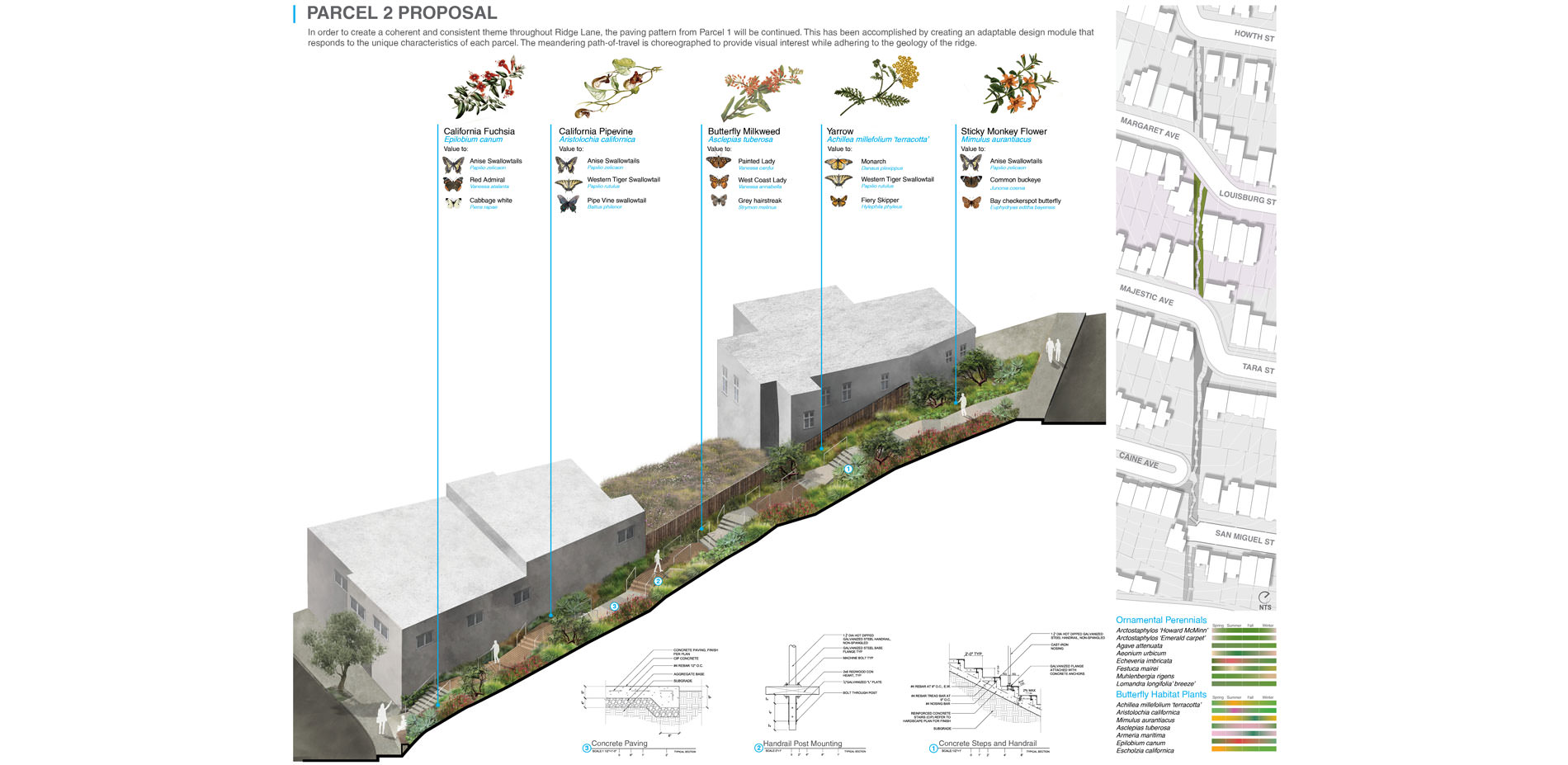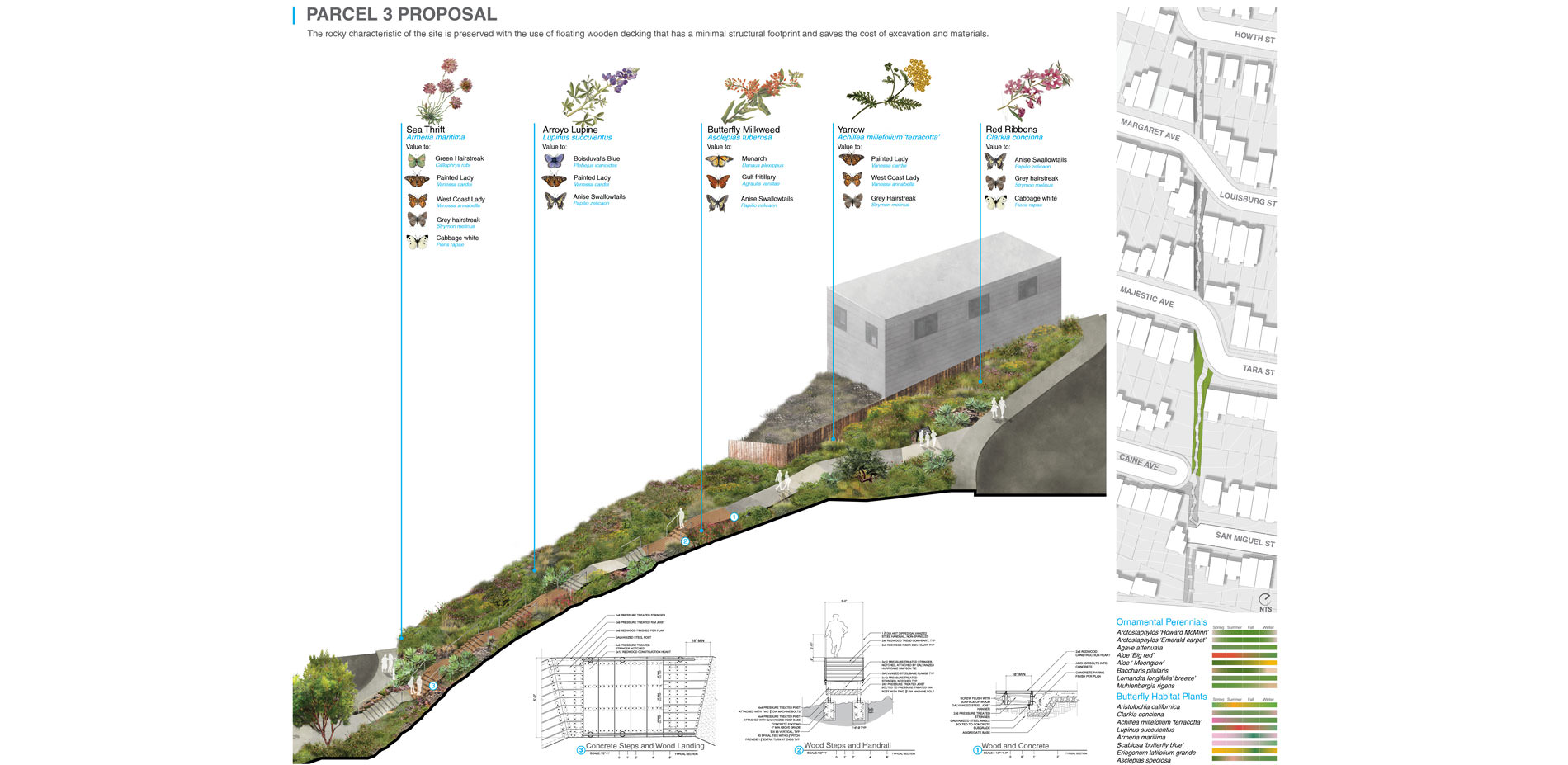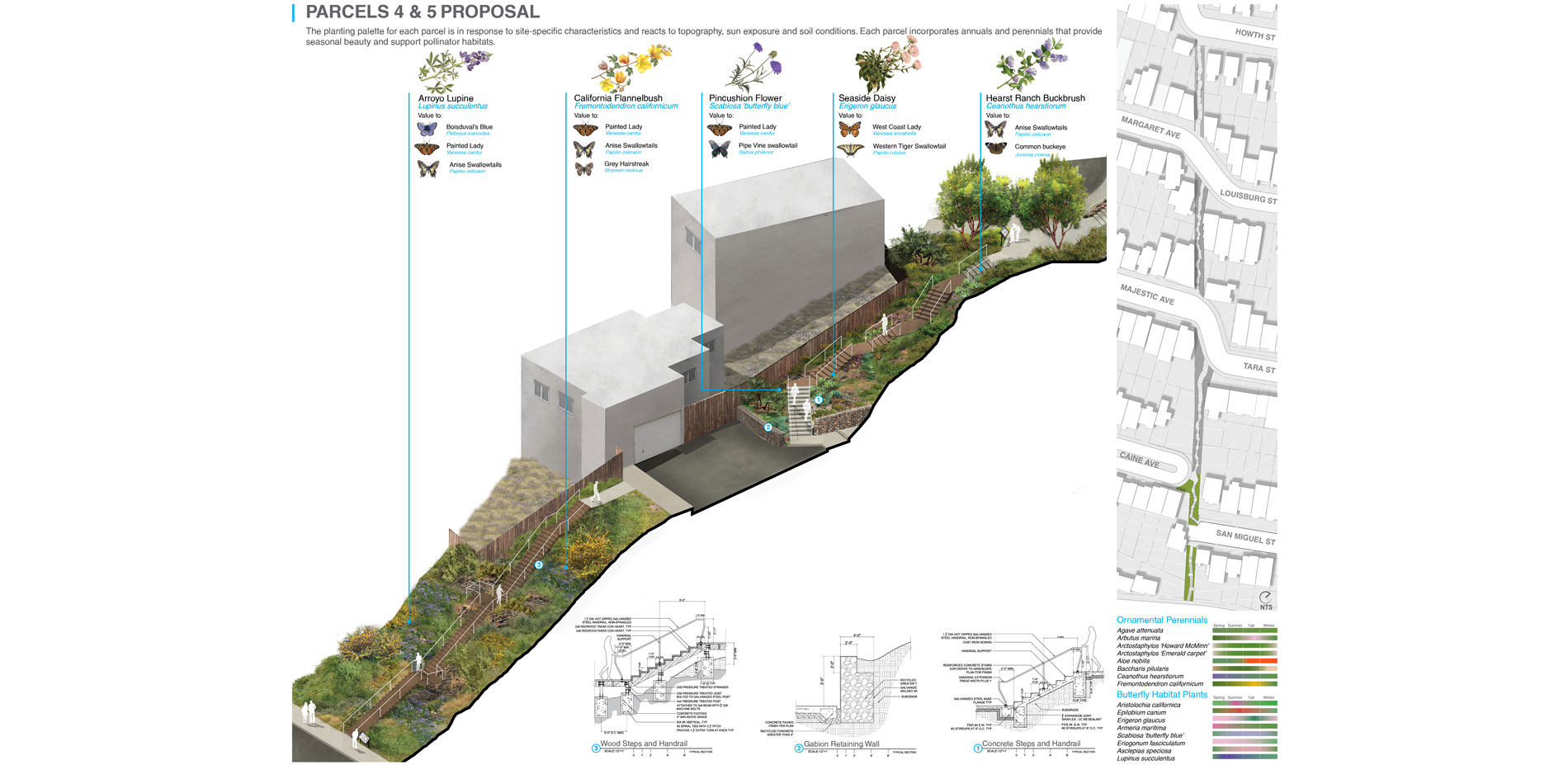Ridge Lane
AWARD OF EXCELLENCE
Student Community Service Award
San Francisco, CA, USA | Nahal Sohbati | Faculty Advisors: Heather Clendenin, Affiliate ASLA; Mary Muszynski, ASLA; Wright Yang
Academy of Art University
They listened to the needs of the residents, and then built something from that. They took it all the way through.
- 2017 Awards Jury
PROJECT CREDITS
Contractor
- Catmex Construction and Maintenance
Supporting Government Agencies
- San Francisco Parks Alliance
- San Francisco Department of Public Works
- Community Challenge Grant
PROJECT STATEMENT
As urbanization grows, the value of public open spaces becomes more vital. The City of San Francisco contains more than 1,500 vacant lots that total an area approximately half the size of Golden Gate Park. Social and biotic values of these scattered and down-trodden sites are underutilized, thus leaving voids in underserved communities.
The Ridge Lane project is a revitalization of one of these vacant lots that has adapted a grass-roots strategy with the goal of empowering the community to become involved in all phases of the project from visioning to implementation, giving them a sense of pride and ownership of their neighborhood.
Meticulous analysis and incorporation of the neighbors’ feedback resulted in a design that celebrates their shared appreciation of Ridge Lane’s unique ecological and social factors.
The metamorphosis of Ridge Lane from an abandoned wasteland to a community gem interweaves ecology, design, and social factors resulting in a beneficial environment for all of its inhabitants.
PROJECT NARRATIVE
Spearheaded by a passionate coalition of neighbors and a student of landscape architecture, Ridge Lane sets a precedent for grassroots activism in dense and socially diverse urban conditions. The revitalization of Ridge Lane employs the fundamentals of landscape architecture to unite a neighborhood based on communal love of shared land.
Located in the Ingleside neighborhood of San Francisco, Ridge Lane is one of 1,500 vacant public spaces owned by the City. The site is 15 feet wide and approximately a quarter mile in length. It is composed of five individual parcels separated by city streets.
Before 1860, the land now occupied by the Ingleside neighborhood was primarily dairy farms and pasturelands with sparse populations. The area was well known for its prolific fields of wildflowers that attracted many visitors. In the late 1800’s development of housing for railroad workers caused the first surge in population. Later the 1906 earthquake brought more residents to this neighborhood and increased the demands for affordable housing in southern San Francisco.
Ridge Lane is an “orphan” space that is a result of the convergent growth between two separately coordinated housing developments. It was plotted out as a street, but due to its insufficient width of 15 feet, it remained vacant for almost a century. Over the years Ridge Lane was considered as “no man’s land” due to a lack of community and city investment. The prevalence of crimes such as robbery, loitering, assault, and frequent dumping of garbage perpetuated Ridge Lane’s undesirable status.
For generations this vacant space has served as an informal path providing a convenient, yet dangerous, shortcut for the residents to navigate within the neighborhood and to access local transit hubs. A trail of trampled plants, exposed rocks, and loose soil are a testament to the need for a safe and convenient path through the neighborhood.
Motivated by the idea that comprehensive design and management can lead to a reduction in crime as well as improving neighborhood life, a core group of 10 committed neighbors worked with landscape architecture graduate students, to explore ideas for conceptual design solutions. After a series of presentations and discussions, this proposal was selected by the neighbors.
The project was then phased according to available funding. The first phase was Parcel 1 at the highest elevation. Due to its relatively flat condition, it provided the opportunity to serve as a common gathering space for neighborhood activities while also serving as a pilot project for the remaining parcels.
The design process of Parcel 1 involved regular monthly meetings and workshops to ensure that all voices and concerns were being heard and addressed. The meetings were well attended and represented the diverse population of the surrounding neighborhoods in terms of ethnicity, gender, and age. Neighbors discussed site elements such as benches, trees, and lighting while sharing their concerns and desires regarding safety, accessibility and aesthetics. The shared goal was to create a pleasing and comfortable space that represents the soul of Ridge Lane while instilling a sense of pride within the neighborhood.
Ridge Lane’s geography and sheltered southern exposure make it a unique and valuable location for a butterfly mating behavior called “hill-topping.” Hill-topping is a mating ritual in which butterflies congregate at the highest point of their local habitat to find a proper mate. Despite extensive urban development and habitat destruction, this area has retained a diverse and healthy population of butterflies throughout the year. The presence of this butterfly habitat is a uniting element and subject of passion amongst the neighbors and was a guiding principal when developing the conceptual design.
The pathway design for Parcel 1 is an abstraction of the venation patterning found in butterfly wings. This speaks to the ecological value of the site as a butterfly and pollinator habitat as well as establishing a unique neighborhood identity. In addition to its symbolic value, this pattern provides varying pockets of space while maintaining a straight line of site and movement that promotes safety and comfort. The plant palette of native water conscious and well-adapted non-natives provides a combination of ecological value as well as year round beauty.
By the spring of 2016, the neighbors approved the design for Parcel 1 and construction was completed by June 2016. On June 18, 2016 Ridge Lane neighbors held an opening ceremony for Parcel 1. Jubilant neighbors of all ages and backgrounds met for the first time and enjoyed the multicultural community they inhabit thanks to the completion of the first parcel of this new neighborhood park.
Since the opening day, events such as planting days and butterfly workshops have been held on site with the goal to educate people of different ages about local butterfly habitat and ways to improve it. During these activities, Parcel 1 has successfully served as a case study to introduce the importance of both host and nectar plants in a butterfly garden. Neighbors have learned about principles applied to Ridge Lane and how to utilize them in their own backyards to enhance the overall neighborhood habitat. During these activities, planting design concepts were introduced to the neighbors and as a result, they were able to apply them in their own designs using California native wildflowers and plants.
With the momentum gained from the success of Parcel 1, the neighbors then set their sights on the completion of the remaining four parcels that make up Ridge Lane. Monthly meetings ensured transparency in decision-making and assignments of volunteer tasks such as applying for grants, fundraising, neighborhood outreach and maintenance. Information gathered from various site visits and design workshops was incorporated in the design of the following parcels. In addition to the neighbors’ feedback, post-occupancy evaluations conducted from the first parcel revealed valuable information for the development of the other parcels. The presence of varying age groups suggests that Ridge Lane has the potential to reward its residents with valuable intergenerational social experiences as well as providing flexible spaces that could adapt to user needs. This is evident in the observation of user-generated programs such as daily Tai CHI exercises. Site elements such as seating areas and a bulletin board serve as a hub that contributes to spontaneous social interactions.
The design of the remaining parcels has been coordinated with the in-house landscape architects and structural engineers of the San Francisco Department of Public Works to ensure its compatibility with city codes and standards. Due to its size and current hazardous conditions, Parcel 4 was chosen to be developed next. Thanks to the finalized plans and conceptual imagery, Ridge Lane Neighbors have acquired a government grant to fund the construction of Parcels 3 and 4.
As of now, one parcel of this project is complete, and Parcels 3 and 4 are projected to be completed next year. Furthermore, what is already accomplished is a sense of community and friendship between neighbors who were once distant from one another. This once insignificant narrow and hazardous vacant lot now motivates and inspires the neighbors to make their voices heard and improve their community for generations to come. Landscape architecture has once again proven to be a unifying force that brings people together based on the communal love of the land they share.
PRODUCTS
LIGHTING
- Reliance Foundry Co. Ltd.

